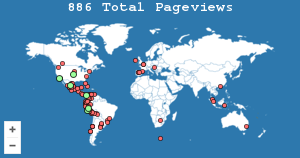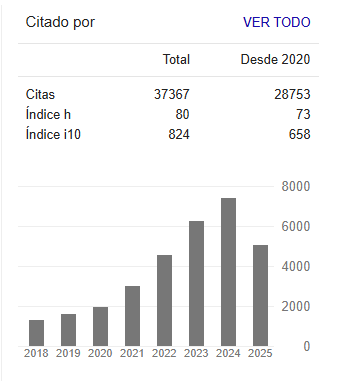Cooperación empresarial en capacidades de los Agronegocios en México
Resumen
Dada la importancia del sector de agronegocios para la economía en México es necesario implementar estrategias que desarrollen ventajas competitivas ante los cambios continuos que presenta la evolución de su entorno. El estudio tiene como objetivo explicar la influencia de la cooperación empresarial (CE) para el desarrollo de capacidades de gestión del conocimiento (GC), uso de tecnologías de información y comunicación (TIC) e innovación abierta (IA) que les permitan ventajas competitivas. Con la técnica de ecuaciones estructurales, se analizaron los resultados de un cuestionario aplicado a los gerentes o en su caso a propietarios de 113 empresas de agronegocios en Aguascalientes, México. Se concluye una relación positiva y significativa entre la CE, y la GC, el uso de TIC e IA. El sector de agronegocios requiere estrategias de cooperación con actores en su entorno para propiciar la creación y transferencia de conocimiento, el uso eficiente de información y la creación de más valor acelerando la innovación.
Citas
Arvaniti, E.N., Dima, A., Stylios, C.D., & Papadakis, V. G. (2022). A New Step-by-Step Model for Implementing Open Innovation. Sustainability, 14(10), 6017. https://doi.org/10.3390/su14106017
Bagozzi, R.P., & Yi, Y. (1988). On the evaluation of structural equation models. Journal of the Academy of marketing science, 16(1), 74-94. https://doi.org/10.1007/bf02723327
Barney, J. (1991). Firm resources and sustained competitive advantage. Journal of Management, 17(1), 99-120.
Ben Khalifa, A. (2023). Impact of research and development (R&D) and information, and communication technology (ICT) on innovation and productivity evidence from Tunisian manufacturing firms. Economics of Transition and Institutional Change, 31(2), 341–361. https://doi.org/10.1111/ecot.12340
Bentler, P.M. (1990). Comparative fit Indexes in structural models. Psychological Bulletin, 107(2), 238- 246. https://doi.org/10.1037/0033-2909.107.2.238
Briones Peñalver, A.J., & Martínez León, I.M. (2006). Tecnologías colaborativas (TIC´ S) para el fomento de la cooperación empresarial.
Bryson, J.M., Crosby, B.C., & Stone, M.M. (2006). The design and implementation of Cross‐Sector collaborations: Propositions from the literature. Public administration review, 66, 44-55. https://doi.org/10.1111/j.1540-6210.2006.00665.x
Byrne, B. M. (2013). Structural Equation Modeling With Lisrel, Prelis, and Simplis (1st Edition). Psychology Press.
Byrne, B.M. (1998). Structural equation modeling with LISREL, PRELIS, and SIMPLIS: basic concepts, applications, and programming Psychology Press. Available at: https://www.proquest.com/openview/2bf41a7a91d34282a0f1d070c2a25a41/1?pq-origsite=gscholar&cbl=36693
Chacón, E., Cruz Salazar, L.A., Cardillo, J., & Paredes Astudillo, Y.A. (2021). A control architecture for continuous production processes based on industry 4.0: water supply systems application. Journal of Intelligent Manufacturing, 32(7), 2061-2081. https://doi.org/10.1007/s10845-021-01790-3
Chandrashekar, D., & Mungila Hillemane, B.S. (2018). Absorptive capacity, cluster linkages, and innovation: An evidence from Bengaluru high-tech manufacturing cluster. Journal of Manufacturing Technology Management, 29(1), 121-148. https://doi.org/10.1108/JMTM-05-2017-0087
Cheng, C.C., & Shiu, E.C. (2015). The inconvenient truth of the relationship between open innovation activities and innovation performance. Management Decision, 53(3), 625-647. https://doi.org/10.1108/MD-03-2014-0163
Corral, Y. (2010). Diseño de cuestionarios para recolección de datos. Revista Ciencias de la Educación, 20(36), 52-168
Cotarelo, M., & Calderón, H. (2017). Cooperation as a Mediator between ICT and Export Success. Journal of Global Marketing, 31(3), 197-209. https://doi.org/10.1080/08911762.2017.1350311
De Arteche, M. (2018). Los clústeres y la gerencia del conocimiento (GC): cooperar y competir. Educar. 54(1) 185-203. https://www.raco.cat/index.php/Educar/article/view/v54-n1-de-arteche
Du, J., & Wang, R. (2019). Knowledge transfer and boundary conditions: a study of SMEs in business incubation centers in China. New England Journal of Entrepreneurship, 22(1), 31-57. https://doi.org/10.1108/NEJE-04-2019-0021
Fawcett, S.E., McCarter, M.W., Fawcett, A.M., Webb, G.S., & Magnan, G.M. (2015). Why supply chain collaboration fails: the socio-structural view of resistance to relational strategies. Supply Chain Management: An International Journal, 20(6), 648-663. https://doi.org/10.1108/SCM-08-2015-0331
Fischer, C. (2021). Incentives can’t buy me knowledge: the missing effects of appreciation and aligned performance appraisals on knowledge sharing of public employees. Review of Public Personnel Administration, 78(2). https://doi.org/10.1177/0734371X20986839
Fong Reynoso, C., Flores Valenzuela, K.E., & Cardoza Campos, L.M. (2017). La teoría de recursos y capacidades: un análisis bibliométrico. Nova scientia, 9(19), 411-440.
Fornell, C., & Larcker, D. F. (1981). Evaluating structural equation models with unobservable variables and measurement error. Journal of marketing research, 18(1), 39-50. https://doi.org/10.1177/002224378101800
Gómez, J., Salazar, I., & Vargas, P. (2022). Production outsourcing, technological cooperation and E-business adoption by Spanish manufacturing firms. Journal of Engineering and Technology Management, 63, 101677. https://doi.org/10.1016/j.jengtecman.2022.101677
Hair, J.F., Anderson, R.E., Tatham, R.L., & Black, W.C. (1995). Multivariate data analysis: With Readings (4th ed.). Prentice Hall.
Helfat, C. E., & Quinn, J. B. (2006). Open innovation: The new imperative for creating and profiting from Technology. The Academy of Management Perspectives, 20(2), 86–88. https://doi.org/10.5465/amp.2006.20591014
Horta, R., Silveira, L. y Ferreira, L. (2021). Obstáculos a la innovación y la cooperación para innovar. Caso de empresas en la industria manufacturera del Uruguay. Económicas CUC, 42(2), 77-98. https://doi.org/10.17981/econcuc.42.2.2021.Org.4
https://repositorio.upct.es/bitstream/handle/10317/900/tcf.pdf?sequence=1&isAllowed=y
Huxham, C. (1996). Creating collaborative advantage. Creating Collaborative Advantage, 1-200. Available at: http://digital.casalini.it/9780857022790
Instituto Nacional de Estadística y Geografía- INEGI (2020). Estadísticas a propósito del día de las micro, pequeñas y medianas empresas (27 de junio) Datos Nacionales. https://www.inegi.org.mx/contenidos/saladeprensa/aproposito/2020/MYPIMES20.pdf
Instituto Nacional de Estadística y Geografía- INEGI (2022a). Producto Interno Bruto a precios corrientes. Primer trimestre de 2022. https://www.inegi.org.mx/contenidos/programas/pib/2013/doc/PIBT2022_05.pdf
Instituto Nacional de Estadística y Geografía- INEGI (2022b). Producto Interno Bruto a precios corrientes. Segundo trimestre de 2022. Recuperado de: https://www.inegi.org.mx/contenidos/programas/pib/2013/doc/PIBT2022_06.pdf
Instituto Nacional de Estadística y Geografía- INEGI (2022c). Producto Interno Bruto a precios corrientes. Tercer trimestre de 2022. Recuperado de: https://www.inegi.org.mx/contenidos/programas/pib/2013/doc/PIBT2022_11.pdf
Instituto Nacional de Estadística y Geografía- INEGI (2023). Producto Interno Bruto a precios corrientes. Cuarto trimestre de 2022. Recuperado de: https://www.inegi.org.mx/contenidos/saladeprensa/boletines/2023/pib_pconst/pib_pconst2023_02.pdf
Iqbal, A., Khan, I., & Jan, S. (2018). A Review and Comparison of the Traditional Collaborative and Online Collaborative Techniques for Requirement Elicitation. Journal of Independent Studies and Research – Computing. https://doi.org/10.23919/ICACS.2019.8689139
Jansen, J.J.P., Van den Bosch, F.A.J., & Volberda, H.W. (2006). Exploratory innovation, exploitative innovation, and performance: effects of organizational antecedents and environmental moderators. Management Science, 52(11), 1661-1674. https://doi.org/10.1287/mnsc.1060.0576
Johnson, B., & Stevens, J.J. (2001). Exploratory and confirmatory factor analysis of the School Level Environment Questionnaire (SLEQ). Learning Environments Research, 4, 325-344.
Jöreskog, K.G., & Sörbom, D. (1981). LISREL V: Analysis of linear structural relationships by maximum likelihood and least squares methods: University of Uppsala, Department of Statistics.
Kumar, A., & Dutta, S. (2017). Tacit knowledge transfer in coopetition: An empirical investigation of the role of business group (BG) affiliation. Journal of Strategy and Management, 10(4), 453-468. https://doi.org/10.1108/JSMA-07-2016-0047
Lee, K., & Yoo, J. (2019). How does open innovation lead competitive advantage? A dynamic capability view perspective. PLoS ONE 14(11): e0223405. https://doi.org/10.1371/journal.pone.0223405
Li, W., & Zhao, X. (2022). Competition or coopetition? Equilibrium analysis in the presence of process improvement. European Journal of Operational Research, 297(1), 180-202. https://doi.org/10.1016/j.ejor.2021.04.031
Lo, F., Chiao, Y., & Yu, C. (2016). Network and Institutional Effects on SMEs’ Entry Strategies. Management International Review, 56(4), 531-563. https://doi.org/10.1007/s11575-016-0289-4
López Estupiñán, A. M., & Peña Mesa, L. (2023). Inteligencia Artificial: el futuro del empleo. Revista Lecciones Vitales, lv0103. https://doi.org/10.18046/rlv.2023.6118
Martinez-Conesa, I., Soto-Acosta, P., & Carayannis, E.G. (2017). On the path towards open innovation: Assessing the role of knowledge management capability and environmental dynamism in SMEs. Journal of Knowledge Management, 21(3), 553-570. https://doi.org/10.1108/JKM-09-2016-0403
Mirzaie, M., Javanmard, H-A., & Reza, H. (2019). Impact of knowledge management process on human capital improvement in Islamic consultative assembly. Knowledge Management Research and Practice, 17(3), 316-327. https://doi.org/10.1080/14778238.2019.1599579
Mousavizade, F., & Shakibazad, M. (2019). Identifying and ranking CFSs for KM implementation in urban water and sewage companies using ISM-DEMATEL technique. Journal of Knowledge Management, 23(1), 200-218. https://doi.org/10.1108/JKM-05-2018-0321
Najib, M., & Kiminami, A. (2011). Competitive strategy and business performance of small and medium enterprises in the Indonesian food processing industry. Studies in Regional Science, 41(2), 315-330. https://doi.org/10.2457/srs.41.315
Oviedo, H. C. y Campo, A. (2005). Aproximación al uso del coeficiente alfa de Cronbach. Revista Colombiana de Psiquiatría, 34(4), 572-580.
Peñalver, A.J., Santos, J.A.C., Conesa, J.A., & Santos, M.C. (2018). Influence of Cooperation and Collaborative ICT in Knowledge Management. Journal of Scientific & Industrial Research, 77, 313-317. http://nopr.niscpr.res.in/handle/123456789/44513
Popa, S., Soto-Acosta, P., & Loukis, E. (2016). Analyzing the complementarity of web infrastructure and elnnovation for business value generation. Program, 20(1), 118-134. https://doi.org/10.1108/PROG-09-2015-0065
Riosvelasco-Monroy, G., Flores-Amador, J. y Pérez-Olguín, I. (2019). Gestión del conocimiento a través de la colaboración horizontal en el Clúster MACH. Revista Internacional de Investigación e Innovación Tecnológica, 7(41). https://www.scielo.org.mx/scielo.php?pid=S2007-97532019000600001&script=sci_arttext
Singh, R., Chandrashekar, D., Hillemane, B.S.M., Sukumar, A., & Jafari-Sadeghi, V. (2022). Network cooperation and economic performance of SMEs: Direct and mediating impacts of innovation and internationalisation. Journal of Business Research, 148, 116-130. https://doi.org/10.1016/j.jbusres.2022.04.032
Soledispa-Rodríguez, X., Álvarez-Rivera, I., Baque-Suárez, A. y Cantos-Castro, B. (2021). Tecnologías de información y comunicación en la gestión empresarial de las PYMES. Polo del Conocimiento (Edición núm. 56), 6(3), 476-496.
Soto-Acosta, P., Popa, S., & Palacios-Marqués, D. (2016). E-business, organizational innovation, and firm performance in manufacturing SMEs: an empirical study in Spain. Technological and Economic Development of Economy, 22(6), 885-904. https://doi.org/10.3846/20294913.2015.1074126
Tippins, M.J., & Sohi, R.S. (2003). IT competency and firm performance: is organizational learning a missing link? Strategic management journal, 24(8), 745-761. https://doi.org/10.1002/smj.337
Trinidad, J., Sánchez, J., y Lozano, K.M. (2020). Implicaciones de las teorías organizativas en la construcción de la cooperación empresarial. Revista de Investigación Aplicada En Ciencias Empresariales, 8(1), 7–31. https://doi.org/10.22370/riace.2019.8.1.2070
Urbinati, A., Manzini, R., Piacentini, D., & Carretti, C. (2021). Implementing open innovation for radical innovation: three successful cases in the SAES group. European Journal of Innovation Management, 25(2), 501-522. https://doi.org/10.1108/EJIM-04-2020-0116
Van Fleet, D. (2016). What is agribusiness? A visual description. Amity Journal of Agribusiness, 1(1), 1-6. https://amity.edu/UserFiles/admaa/203Viewpoint.pdf
Whitehead, K., Zacharia, Z., & Prater, E. (2019). Investigating the role of knowledge transfer in supply chain collaboration. International Journal of Logistic Management, 30(1), 284–302. https://doi.org/10.1108/IJLM-07-2017-0184
Wu, I-L., & Hu, Y-P. (2018). Open innovation-based knowledge management implementation: a mediating role of knowledge management design. Journal of Knowledge Management, 22(8), 1736-1756. https://doi.org/10.1108/JKM-06-2016-0238
Yiu, D., Lau, C., & Bruton, G. (2007). International venturing by emerging economy firms: the effects of firm capabilities, home country networks, and corporate entrepreneurship. Journal of International Business Studies, 38(4), 519-540. https://doi.org/10.1057/palgrave.jibs.8400278
Zhong, R., Wang, D., Hu, C., Li, Y., & Feng, G. (2022). Prediction and Control of Input and Output for Industry–University–Research Collaboration Network in Construction Industry. Processes, 10(10), 2037. https://doi.org/10.3390/pr10102037
Zimmer, J., Walecka-Jankowska, K., & Mierzwa, D. (2019). Inter-organizational Cooperation as part of Open Innovation. Journal Innovation & Business Best Practice, 19, 1-11. https://doi.org/10.5171/2019.729117

Esta obra está bajo licencia internacional Creative Commons Reconocimiento-NoComercial-CompartirIgual 4.0.








.png)






























